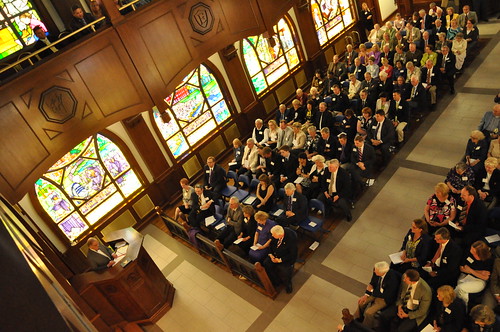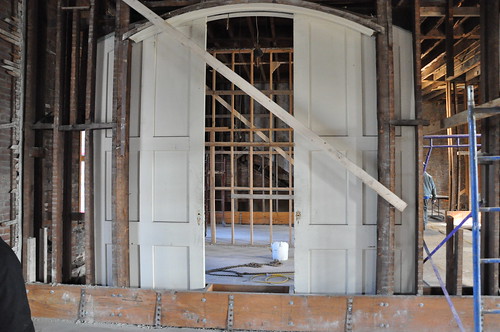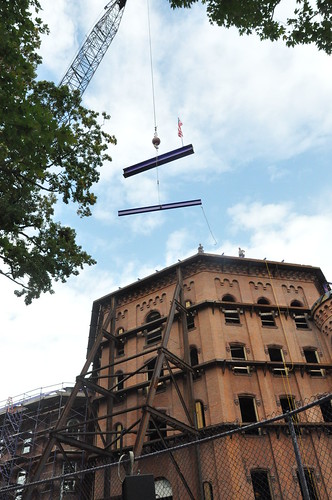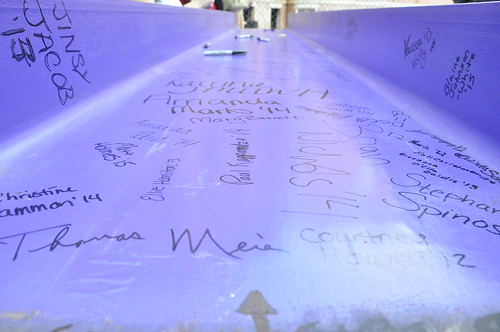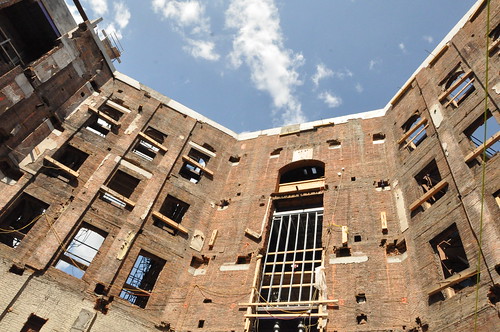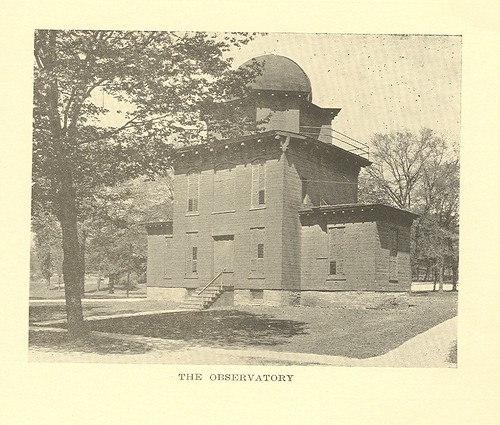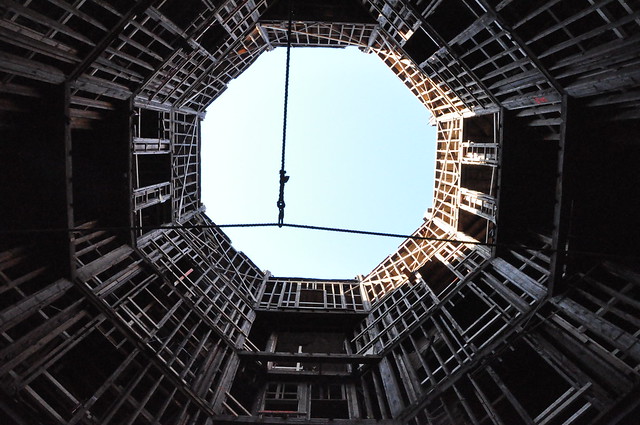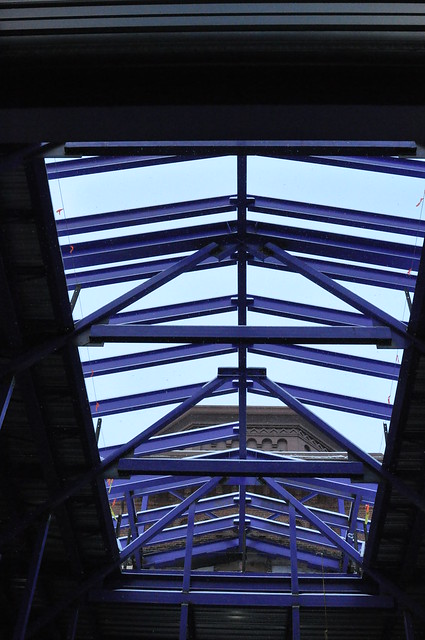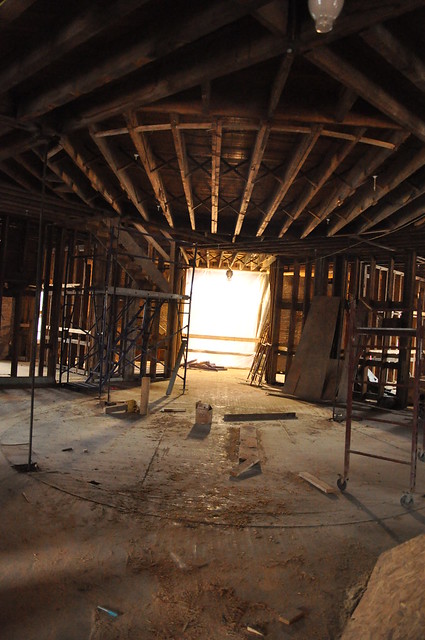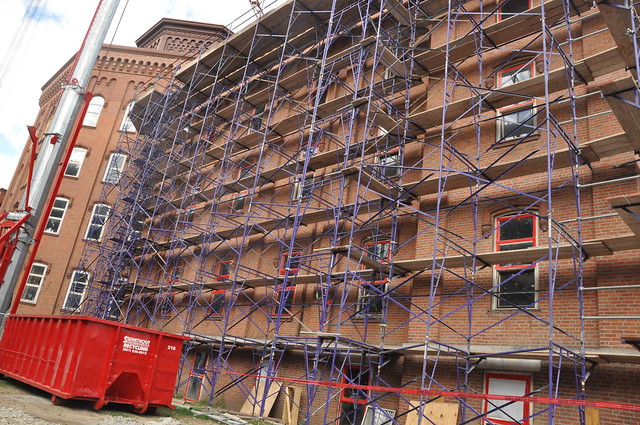With all the work going into the original campus building, I have been doing some research on other campus buildings. Some that are no longer here and others that never were. I thought I would write about the College observatory.
EIGHT-TENTHS of a century elapsed between the breaking of ground for Elmira College's observatory in 1858 and the final setting of a little cloud of historic dust upon the triangular plot east of Tompkins Hall and the president's home.
The little brown-domed observatory, next to Cowles Hall, the college's oldest building, was a landmark dear to Elmira students, a monument to Professor Farrar, a workshop for Dr. Ford, a meeting place for the distinguished company which comprised the Elmira Academy of Sciences-and the scene of "dome parties" which fill the heart of many an alumna with memories in which nostalgia tinges happiness, a not uncommon characteristic of memories.
The observatory was built because Professor Farrar was both an astronomer and a go-getter. Its history can be traced in the minuscule type of yellowing college catalogues and old clippings, by anyone interested in acquiring acute astigmatism. Its significance lies in the fact it was an Elmira College "first," and in what it contributed to a struggling and impecunious institution both as a classroom and as the gathering place for some of the greatest men Elmira ever knew-men whose work goes on to this day, far more durable than the flesh and bone of its beginners.
Science was a magnet so powerful that it could draw together men like Beecher and Mark Twain, Farrar, Brockway, and Ford, and hold them together through long years as a great and unusual force in the community's cultural development and an endless inspiration to the college.
So it was no ordinary dust that settled on the triangle bounded by Sixth Street, College Avenue, and Park Place that, summer's day in 1939, when the last stone of the old observatory's foundation was hauled away and only in memory did there remain a dome to glow with light whose travels are measured in years. The observatory had its beginning in 1858 when Farrar borrowed a 4-inch refractor from S. G. Camp of Owego. The students were so interested that an attempt was made to purchase it (Camp was willing to sell it for $275) but the effort failed. However, the idea didn't die (few of Farrar's did), and by February 1859, under his energetic promotion, a campaign to buy a 6-inch telescope was successfully completed. Then an 8inch telescope came to Farrar's attention. It had been used by S. M. Rutherford and Prof. C. W. Hackley of Columbia, and it was available from Henry Fitz of New York for $1,820, a price Fitz was willing to shade to $1,600. Farrar bought it with an $800 chattel mortgage to adorn the transaction.
So fine an instrument deserved a suitable home and Farrar set out to raise $3,000. It was a difficult job but he was determined, and Elmirans then as now were a generous lot. Farrar surveyed numerous sites for his observatory. One on the college grounds was found unsuitable because the college tower obscured the view; in any case, the trustees didn't welcome to the campus any addition that was darkened by an eclipse of debt. E. P. Brooks stepped forward with the offer of the triangle, and the offer was accepted by Farrar with disarming alacrity for a variety of reasons, chief among which was the fact that the plot "would cost nothing."
Alisha Kingsbury drew the plans for what Callisophia for September-October, 1860, described as a "26-foot cube with symmetrical wings for Transit Room and Library, and mounted with an octagonal observing room and revolving dome."
Ground was broken August 8, 1859, and the building went into service April I, 1860. The following year the Elmira Academy of Sciences was founded, with the Reverend Thomas K. Beecher as its first president. After two decades, the Academy turned the observatory over to the college, complete with its excellent equipment and a wonderful heritage to boot.
Elmira College catalogues invariably contained a description of the observatory and its furnishings until 1928-29. By that time the old building had served its purpose, and time had taken its toll. It passed on before the nation's juke boxes issued strident warnings against letting the stars get in your eyes.
Drs. Farrar and Ford and the students weren't averse to starlight, and even Miss Bronson went along with the observations of celestial doings although she knew that these observations were enlivened with snacks and the levity which nocturnal feasting can engender.
Two brief accounts of the meteor shower of 1868 throw a mellow light on the observatory and its occupants eighty-seven years ago. One, by Mary C. Davis ’69, follows, in part:
... On November 14, 1868, our class in astronomy took our positions about the dome of the observatory. We divided the heavens into ten sections, with the stipulation that each girl should count only the meteors which seemed to originate in her section, in order to avoid duplication. About eleven P .M. a perfect Kappa Sigma appeared in the northwest, quite a proper thing to do as we were all members of Kappa Sigma sorority. From that time the meteors came thick and fast and we counted over five thousand till the rising sun obscured their view. Dr. Ford of blessed memory furnished us with "eats" and blankets, for it certainly was frosty that November night.
In the many years that followed I never found anyone who had seen that shower. Two or three years ago I wrote to Professor Fisher of Harvard, making inquiries. He replied that he had never found anyone who had witnessed it, that I was the first one to give him a detailed account of it. Later I wrote to the Museum of Natural History, New York, and my account was read at a meeting of the Amateur Astronomical Association of New York. A man employed by the museum had seen the shower in mid-ocean on his way from England to the United States.
To this, Mrs. Nora Stanford Wells '73 added:
I can remember it so well… The day was perfect and at dinner, 12:30 P.M. Dr. Ford gave us a good talk on the subject and the prospect of a wonderful display. The Seniors were to sit up all night at the Observatory, the usual custom on that date. You can imagine the excitement. At supper, Miss Bronson gave us a few words in regard to putting on heavy gowns and going wherever we liked to see the show. Dr. Ford had said that the weather still held and he expected one of the finest displays ever witnessed. He would send word to the college, have the bell rung and no one must miss it. Such excitement! The beautiful Seniors of 1868 were just full of "pep, vim and vigor," laughing and so mysterious that it nearly set us youngsters crazy, for they wouldn't tell us anything. Then the preparations being made at the Observatory-great baskets full of delicious things being carried down, etc! Of course, no one slept much, and when the bell rang we were out in a jiffy, slipped into our clothes, grabbed a comfortable or blanket and away we went, most of us to the cupola. Such a sight! I have never seen anything like it since, though I have watched many a time. Dr. Ford's expectations were fully realized and it was a joyous astronomy class who strolled home about 4 A.M. and had the right to sleep all that day.
When '73's turn came, all the usual preparations were made, but there wasn't a star to be seen, and after vainly trying all the instruments, we ate our spread and tramped back, and were in bed by eleven o'clock. It was a terrible disappointment for '73 was a lucky class and we expected as fine a shower as came for '68.
